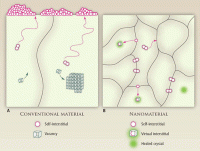
New nuclear build, both fusion and fission, now seems inevitable in many countries. Crucial to the safety and lifetime of reactors is the degradation of the steels from which they are made due to radiation. The ability of a material to resist radiation damage is determined by how well the microstructure can remove vacancies and interstitial defects in equal numbers. In this week's Science, Prof Graeme Ackland proposes that nanomaterials can be used as catalysts for healing damage, or as nanodustbins for storing embrittling byproducts such as Helium.

The School of Physics & Astronomy is part of today’s significant developments at the European Organisation for Nuclear Research (CERN).
Physicists from the University of Edinburgh are working at the Large Hadron Collider (LHC) as it starts to smash sub-atomic particles together with a record level of energy – 7 trillion electron-volts (TeV).
The powerful particle collisions mark the beginning of LHC’s first high-energy activity.
Experiments at the LHC will collect data that may provide evidence of the Higgs boson. The existence of this theoretical particle was first postulated by Professor Peter Higgs when he was a researcher at the University in the 1960s. It will be a remarkable achievement for physics if his predictions are correct.
About 20 physicists from the University perform research at CERN, working on the ATLAS and LHCb detectors which analyse collision data from the LHC as it recreates the conditions of the Big Bang.
The researchers’ work on ATLAS involves modelling and simulating the particle collision process to help understand the detector’s response and the complex data produced by the experiments. They also contribute to the operation of the ATLAS detector itself and provide software to manage the data produced.
Dr Philip Clark, School of Physics and Astronomy, said, “We are delighted to be involved with CERN as the new high-energy run gets under way. The Large Hadron Collider is expected to advance significantly our knowledge of physics and as such represents an enormously important development.”
The Edinburgh group works on the Ring Imaging Cherenkov (RICH) detectors for the LHCb experiment. The RICH detectors are built to distinguish between kaons and pions, which are different types of charged particles. Their proper identification is crucial for measuring differences between particles and antiparticles. The LHCb experiment aims to understand the matter-antimatter asymmetry in the Universe.
Prof. Franz Muheim, School of Physics and Astronomy, states: “Today is the start of a new era for particle physics. We have worked hard over more than a decade to design, build and commission the LHCb experiment. Thus we are very excited to have started data-taking at the LHC. This is a giant step into unknown territory and the LHC will hopefully reveal a few secrets of Nature.”
The LHC research may shed light on other important unsolved questions in physics. These include furthering scientists’ knowledge of dark matter and explaining why the Universe is made from matter, not anti-matter.
Physics exhibition
To mark today’s CERN milestone, the School is holding an exhibition in the forum of the University’s Main Library. This will be followed by a presence at the Science Festival.
The display, which is run by Alan Walker of the Particle Physics Experiment group, features a series of experiments relating to particle physics and the search for the Higgs boson.
Picture gallery
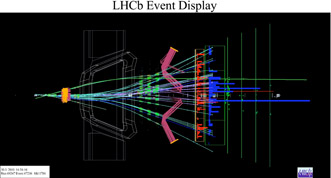
An LHCb event recorded at 7 TeV

Happy researchers in the LHCb control room, including Conor Fitzpatrick (foreground), a 2nd year PhD student, who is involved in calibrating the RICH detectors.
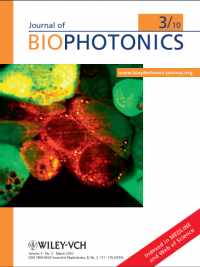
COSMIC is a collaboration between the University's schools of Physics & Astronomy, Chemistry, Biology and Medicine. It has pioneered the use of spectroscopy and imaging techniques to study how viral infections affect cells. The cover image of the latest issue of the Journal of Biophotonics shows one of COSMIC's images of cells under viral attack.
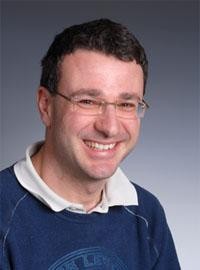
Dr Davide Marenduzzo has been awarded the 2010 Young Scientist Prize by the C3 Commission on Statistical Physics of the International Union of Pure and Applied Physics (IUPAP).
The citation for the prize recognizes Davide's contributions to the statistical mechanics of biomolecular and soft matter systems, in particular his groundbreaking simulations of DNA organization, liquid crystals and active gels.
Davide will receive his prize at the StatPhys24 conference in Cairns, Australia in July. The Young Scientist Prize in Statistical Physics recognises outstanding achievements by scientists in the early stages of their career working in the broad field of Statistical Physics.
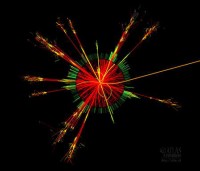
Software was highlighted as a key facility needed for high quality research by a recent Engineering and Physical Sciences Research Council (EPSRC) consultation. A sustained future for this valuable resource has now been assured thanks to a £4.2 million grant from EPSRC, which will establish the UK’s Software Sustainability Institute (SSI).
EPCC at the University of Edinburgh will lead a team of academics and software engineers based at the University of Southampton’s School of Electronics and Computer Science and the Department of Computer Science at the University of Manchester. The groups will work in partnership with the research community to manage software beyond the lifetime of its original funding, so that it is strengthened, adapted and customised to maximise its value to future generations of researchers.
“The issue at the moment is that there are no co-ordinated ways of sustaining important research software once it comes to the end of its funding,” said Neil Chue Hong, Director of the SSI and OMII-UK. “Some software gets abandoned when the project ends. Some systems are maintained in pockets on very much a best-effort basis rather than on the basis of any longer term strategy.”
Mr Chue Hong and his collaborators will work with 30-40 groups across the UK, providing the expertise needed to create self-sustaining communities of researchers around important software. It is these communities that will ensure the software’s future by keeping it up-to-date and developing it to meet new requirements. A wide range of disciplines are set to benefit from the SSI’s work, with early projects encompassing climate change, nuclear fusion and medical imaging.
The SSI will collaborate with key researchers to identify and shape the software which is considered by its community to be the most important for research. Strategies for sustaining software will be optimised, and the best methods will be communicated to researchers through SSI consultancy. This work will help to stop the decay of software. “The creation of the SSI will ensure that important software is sustained so that it can continue to contribute towards high quality research” said Mr Chue Hong.
Further Information
-
Dr Mark Parsons, EPCC Commercial Director.
+44 (0)131 650 5022
m.parsons [at] epcc.ed.ac.uk -
Neil Chue Hong, Director of SSI and OMII-UK,
+44 023 8059 8862,
N.ChueHong [at] omii.ac.uk

Dr Richard Blythe, member of the Institute for Condensed Matter and Complex Systems, has been recognised by the publisher of top physics journal "Physical Review Letters" as an "Outstanding Referee". This award, bestowed by the American Physical Society, is in appreciation of the care he has taken in reviewing papers submitted to APS journals to help ensure that those that are eventually published meet the highest scientific standards.
Dr Blythe is one of about 150 physicists from 35 countries selected to appear on the 2010 roll of honour for the quality, number and timeliness of reports on articles submitted to APS journals. He joins Prof Mike Cates FRS as the second Edinburgh physicist to receive this award.
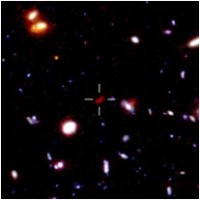
Galaxies which are likely to be the most distant yet seen have been identified by two teams of UK astronomers using the recently updated Hubble Space Telescope (HST).
The UK teams, one led by Andrew Bunker and Stephen Wilkins at the University of Oxford and the other by Ross McLure and Jim Dunlop at the University of Edinburgh, analysed infrared images from the new Wide Field Camera 3 (WFC3) instrument on HST, installed during the most recent Space Shuttle servicing mission in May 2009.
Infrared light is light invisible to the human eye, with wavelengths about twice as long as visible light – beyond those of red light.
"The expansion of the Universe causes the light from very distant galaxies to appear redder, so having a new camera on Hubble which is very sensitive in the infrared means we can identify galaxies at much greater distances than was previously possible," said Stephen Wilkins, a postdoctoral researcher in astrophysics at Oxford University.
In a series of papers, to appear in the Monthly Notices of the Royal Astronomical Society, the UK teams present their analysis of the most sensitive images of the Universe yet taken in the infrared.
"The unique infrared sensitivity of Wide Field Camera 3 means that these are the best images yet for providing detailed information about the first galaxies as they formed in the early Universe", said Dr Ross McLure of the Institute for Astronomy in Edinburgh.
The new images from Hubble include the region of sky known as the Hubble Ultra Deep Field, which Bunker and colleagues were the first to analyse five years ago using visible light images taken with Hubble's Advanced Camera for Surveys (ACS).
"Hubble has now revisited the Ultra Deep Field which we first studied five years ago, taking infrared images which are more sensitive than anything obtained before. We can now look even further back in time, identifying galaxies when the Universe was only five per cent of its current age – within 1 billion years of the Big Bang," said Dr Daniel Stark, a postdoctoral researcher at the Institute of Astronomy in Cambridge who was involved in the work of both UK teams.
As well as identifying potentially the most distant objects yet, these new HST observations present an intriguing puzzle.
"We know the gas between galaxies in the Universe was ionised (where electrons are removed from their host atomic nuclei) early in the history of the cosmos, but the total light from these new galaxies may not be sufficient to achieve this," said Andrew Bunker, a researcher at the University of Oxford.
The researchers are now looking forward to seeing these intriguing objects more clearly in the years ahead.
"These new observations from HST are likely to be the most sensitive images Hubble will ever take, but the very distant galaxies we have now discovered will be studied in detail by Hubble's successor, the James Webb Space Telescope, which will be launched in 2014," commented Professor Jim Dunlop at the University of Edinburgh.
Further Information
The results are included in three separate papers in the journal Monthly Notices of the Royal Astronomical Society:
R.J. McLure, J.S. Dunlop, M. Cirasuolo, A.M. Koekemoer, E. Sabbi, D.P. Stark, T.A. Targett, R.S. Ellis, Accepted in the Monthly Notices of the Royal Astronomy Society.
Stephen M. Wilkins, Andrew J. Bunker, Richard S. Ellis, Daniel Stark, Elizabeth R. Stanway, Kuenley Chiu, Silvio Lorenzoni, Matt J. Jarvis, Accepted in the Monthly Notices of the Royal Astronomy Society.
Bunker, Andrew; Wilkins, Stephen; Ellis, Richard; Stark, Daniel; Lorenzoni, Silvio; Chiu, Kuenley; Lacy, Mark; Jarvis, Matt; Hickey, Samantha, Submitted to the Monthly Notices of the Royal Astronomy Society.
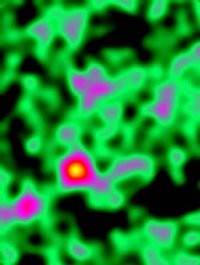
Scottish astronomers are pre-eminent in their field, according to analysis of published scientific research.
Read the full story in Times Higher Education.
Pooling expertise
The statistics highlight the expertise of the Scottish Universities Physics Alliance (SUPA), a pooling arrangement which includes researchers from the Universities of Glasgow, Edinburgh, St Andrews, Strathclyde, West of Scotland, and Heriot-Watt University.
SUPA has benefited from recruitment of world-class staff and through collaboration.
Leading technology
Scottish success in astronomy has been made possible by developments such as the SCUBA submillimetre camera, which rivals the Hubble telescope in terms of its impact on astronomy.
The device has helped scientists obtain heat-generated images of early galaxies, and shed light on the formation of our solar system.
Scottish astronomers are proud to be leading the world in terms of research quality. With investment from SUPA, we expect to continue our success in working on the biggest challenges in modern astronomy, such as extrasolar planets or the nature of dark energy in cosmology.
Head of the Institute for Astronomy
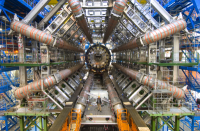
Physicists from Edinburgh are to join the quest for the Higgs boson particle at CERN in Switzerland.
The researchers will join the international ATLAS collaboration seeking to verify the existence of the theoretical sub-atomic particle, a crucial part of the Standard Model of Particle Physics and Cosmology.
The ATLAS experiment aims to address the most important unsolved questions in the universe, i.e., whether or not, the Higgs boson exists, and what the fundamental particle mass generation mechanism is. It could also discover the origin of dark matter and new physics models of nature (e.g. super-symmetry).
Higgs theory
Emeritus Professor Peter Higgs predicted the existence of the Higgs particle while working at the University in the 1960s. If experiments at CERN’s massive atom-smasher prove the Professor’s theory correct, he is tipped to win the Nobel Prize for physics.
Joining the research at CERN are Dr Philip Clark, Dr Victoria Martin, Dr Andy Buckley, Dr Wahid Bhimji and Dr Andy Washbrook together with students Ben Wynne, Ben Smart and Brendan O’Brien and technician Andrew Main.
They will work on the ATLAS detector, one of four experiments analysising collisions at the Large Hadron Collider as it aims to recreate the conditions of the Big Bang.
Impact of research
Their work will involve modelling and simulating the particle collision process in order to understand the detector response and the complex data produced by the experiments. They will also contribute to the operation of the detector itself and provide software to manage the data produced.
Global partnership
Physicists from Edinburgh are already involved in another project at CERN (LHCb) but, until now, have not taken part directly in the search for the Higgs Boson.
The Edinburgh team joins the collaboration, involving 2900 people in 37 countries, after a year of preparatory work with support from colleagues in the Scottish Universities Physics Alliance.
Quote
This project represents the pinnacle of the UK’s ongoing research in particle physics, and is likely to dominate the field for the next 15 years. Our work could contribute to a paradigm shift in our current understanding of the physical universe.
Dr Philip Clark,
School of Physics and Astronomy

Peter Higgs, Emeritus Professor of Theoretical Physics at the University of Edinburgh, will this year give the Oskar Klein Memorial Lecture and will receive the Oskar Klein medal. Sponsored by the Nobel committee of the Royal Swedish Academy of Sciences and by Stockholm University, the lecture will take place in Stockholm on October 1 and honours the memory of Oskar Klein (1894-1977) who worked with Niels Bohr in Copenhagen before becoming a professor of theoretical physics at Stockholm University. The Oskar Klein Memorial Lecture was first held in 1988 and past speakers include Steven Weinberg, Hans Bethe, Martin Rees, and Stephen Hawking to name but a few.

